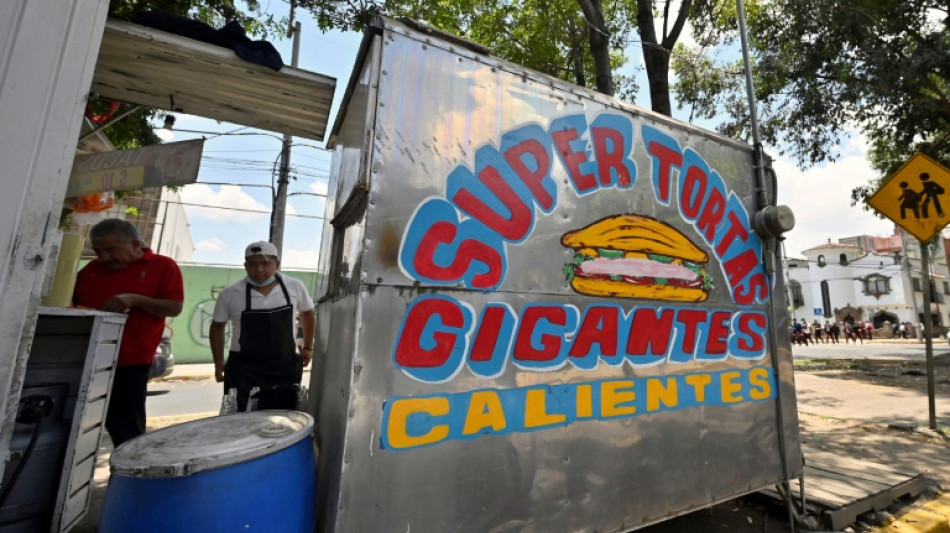
-
 Shiffrin wins Levi slalom for 98th World Cup victory
Shiffrin wins Levi slalom for 98th World Cup victory
-
Israel pummels south Beirut as Lebanon mulls truce plan

-
 Religious Jews comfort hostages' families in Tel Aviv
Religious Jews comfort hostages' families in Tel Aviv
-
German Greens' Robert Habeck to lead bruised party into elections

-
 Johnson bags five as Australia beat Pakistan to seal T20 series
Johnson bags five as Australia beat Pakistan to seal T20 series
-
Zelensky says wants to end war by diplomacy next year

-
 Rugby Union: Wales v Australia - three talking points
Rugby Union: Wales v Australia - three talking points
-
10 newborns killed in India hospital fire

-
 Veteran Le Cam leads Vendee Globe as Sorel is first to quit
Veteran Le Cam leads Vendee Globe as Sorel is first to quit
-
Bagnaia on pole for Barcelona MotoGP, Martin fourth

-
 UN climate chief urges G20 to spur tense COP29 negotiations
UN climate chief urges G20 to spur tense COP29 negotiations
-
Rauf takes four as Pakistan hold Australia to 147-9 in 2nd T20

-
 World not listening to us, laments Kenyan climate scientist at COP29
World not listening to us, laments Kenyan climate scientist at COP29
-
Philippines warns of 'potentially catastrophic' Super Typhoon Man-yi

-
 Wales take on Australia desperate for victory to avoid unwanted record
Wales take on Australia desperate for victory to avoid unwanted record
-
Tyson beaten by Youtuber Paul in heavyweight return

-
 Taylor holds off bloodied Serrano to retain undisputed crown
Taylor holds off bloodied Serrano to retain undisputed crown
-
Japan PM expresses concern to Xi over South China Sea situation

-
 Tens of thousands flee as Super Typhoon Man-yi nears Philippines
Tens of thousands flee as Super Typhoon Man-yi nears Philippines
-
Hoilett gives Canada win in Suriname as Mexico lose to Honduras

-
 Davis, James spark Lakers over Spurs while Cavs stay perfect
Davis, James spark Lakers over Spurs while Cavs stay perfect
-
Mushroom houses for Gaza? Arab designers offer home-grown innovations

-
 Gabon votes on new constitution hailed by junta as 'turning point'
Gabon votes on new constitution hailed by junta as 'turning point'
-
Young Libyans gear up for their first ever election

-
 Vice tightens around remaining civilians in eastern Ukraine
Vice tightens around remaining civilians in eastern Ukraine
-
Dutch coalition survives political turmoil after minister's resignation

-
 Uruguay end winless run with dramatic late win over Colombia
Uruguay end winless run with dramatic late win over Colombia
-
Max potential: 10 years since a teenage Verstappen wowed in Macau

-
 Tens of thousands flee as Typhoon Man-yi nears Philippines
Tens of thousands flee as Typhoon Man-yi nears Philippines
-
Is Argentina's Milei on brink of leaving Paris climate accord?

-
 Big Bang: Trump and Musk could redefine US space strategy
Big Bang: Trump and Musk could redefine US space strategy
-
Revolution over but more protests than ever in Bangladesh

-
 Minister resigns but Dutch coalition remains in place
Minister resigns but Dutch coalition remains in place
-
Ireland won 'ugly', says relieved Farrell

-
 Stirring 'haka' dance disrupts New Zealand's parliament
Stirring 'haka' dance disrupts New Zealand's parliament
-
England's Hull grabs lead over No.1 Korda at LPGA Annika

-
 Kosovo players walk off in Romania after 'Serbia' chants, game abandoned
Kosovo players walk off in Romania after 'Serbia' chants, game abandoned
-
Kosovo players walk off in Romania game after 'Serbia' chants

-
 Lame-duck Biden tries to reassure allies as Trump looms
Lame-duck Biden tries to reassure allies as Trump looms
-
Nervy Irish edge Argentina in Test nailbiter

-
 Ronaldo at double as Portugal reach Nations League quarters, Spain win
Ronaldo at double as Portugal reach Nations League quarters, Spain win
-
Fitch upgrades Argentina debt rating amid economic pain

-
 Trump picks Doug Burgum as energy czar in new administration
Trump picks Doug Burgum as energy czar in new administration
-
Phone documentary details struggles of Afghan women under Taliban

-
 Ronaldo shines as Portugal rout Poland to reach Nations League last-eight
Ronaldo shines as Portugal rout Poland to reach Nations League last-eight
-
Spain beat Denmark to seal Nations League group win

-
 Former AFCON champions Ghana bow out as minnows Comoros qualify
Former AFCON champions Ghana bow out as minnows Comoros qualify
-
Poland, Britain reach BJK Cup quarter-finals

-
 At summit under Trump shadow, Xi and Biden signal turbulence ahead
At summit under Trump shadow, Xi and Biden signal turbulence ahead
-
Lebanon said studying US truce plan for Israel-Hezbollah war


Order to remove Mexican street food signs leaves bitter taste
The erasure of colorful pictures of tacos and other mouth-watering street food from stands in the heart of Mexico City has dismayed fans of the signs, considered part of the capital's identity.
The mayor's office in the district of Cuauhtemoc, which includes the city's historic center and several other traditional neighborhoods, ordered the removal of the images that adorned hundreds of food kiosks.
They have been replaced by a nondescript government sign declaring that Cuauhtemoc -- one of 16 districts in the sprawling capital -- "is your home."
It is a matter of "order and discipline" to improve the city's image, said the district's mayor, Sandra Cuevas, who snatched the position from the ruling left-wing party in last year's elections.
It may seem like a minor matter in a city of nine million people plagued by heavy traffic, pollution and the risk of deadly earthquakes -- but the metal stands, where thousands gather to eat, and their signs are part of the city's DNA, according to a citizen group opposed to the move.
"It's an attack on the identity of the city and of all Chilangos (residents of the capital)," Aldo Solano, a 35-year-old art historian, told AFP.
"They erased many signs that are popular art, part of the traditional image" of the city, he added.
- Decades-old tradition -
The signs themselves represent the menu of the street food stalls, which number in the thousands across the capital.
Drawings of steaming tacos or a smiling pig in a saucepan leave no doubt that here you can savor the famous Mexican tortilla-based dish, or pork "carnitas" fried in lard.
The illustrations date back to the beginning of the 20th century when Mexico had high rates of illiteracy.
"That's why an iconography was used. Now it's not the case, but the tradition has been preserved," Solano said.
The goal of competing food vendors is to be easily noticed by hungry customers in a crowded public space.
"It's a basic marketing tool," said Tamara de Anda, 28, a member of a group that is building a digital archive of city signs with input from citizens.
Vendors fear customers will now find it harder to know what each stall sells, but they dare not protest due to fears of getting in trouble.
"They told us 'take it away or take it away,'" said a fruit juice vendor who did not want to be named.
- 'Big mistake' -
Mayor Cuevas, 36, has been involved in several controversies.
In March she was temporarily suspended from office for assaulting some police officers, to whom she had to apologize.
Even before she was elected, she was accused by Mexico City officials of "extorting" informal merchants so they could work, which she denies.
Since 1985, Adan Navarrete has painted numerous storefronts with drawings like a chef showing off a dish or a smiling clown for a children's party store.
However, his business began to decline with the adoption of new painting techniques in the 1990s.
The removal of the street food signs -- which the 53-year-old calls a "very big mistake -- is another blow.
"Maybe it seems ugly, but it's art," he said.
He fears that some of the creations, which were periodically retouched, are now lost forever.
"It's very difficult to do it again, because many of the masters (who painted them) no longer exist," he said.
O.Ortiz--AT




